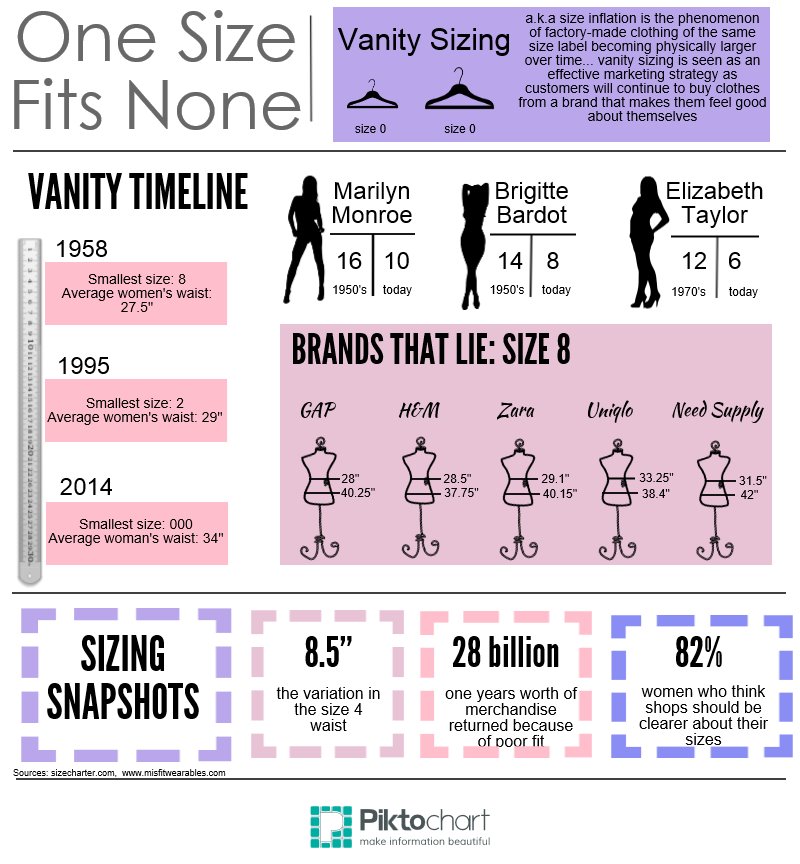
Vanity sizing
LINDSEY Turnbull, 26, hesitated before trying on the dress of her dreams. Long, elegant and eye-wateringly expensive, it was also a size 8 – a size she hadn’t fit into since high school.
Holding her breath, Lindsey slid the dress over her head and pulled up the zip.
It fit.
She’d never parted with money so quickly.
What Lindsey didn’t know is that she’d just become the victim of vanity sizing, a practice where clothing manufacturers assign smaller numbered sizes to larger items of clothing to boost their customers self-esteem and promote brand loyalty.
But in a society that condones weight stigmatization and values the thin-ideal, there’s little wonder this trend is doing women more harm than good
Dr Mair Underwood, specialist in sociology of the body at the University of Queensland, says that vanity sizing reinforces the idea that your size determines your acceptability and worth.
“We use clothes sizes to judge the acceptability of our bodies, but if clothes sizes are inconsistent then how can our views be accurate or realistic?”
Dr Underwood says a distorted body image is one of the criteria for several body-related psychopathologies, such as anorexia and muscle dysmorphia.
“It’s hard enough to avoid some level of body image distortion with all the body shaming and unrealistic ideals we have in our society… adding vanity sizing to the mix to me seems irresponsible.”
Dr Gary Bennett, professor of psychology, global health and medicine at Duke University agrees that vanity sizing is a duping of the customer.
“For some reason, it’s become popular for us to tell women to gauge their weight via the fit of their clothes… some seem to think this is an approach that is easier for them to bear emotionally, but their self-worth is on shaky foundations when it’s based on a lie.”
Joan Gutierrez, writer for Fiterazzi Magazine and author of the article The Power of The Size Tag says vanity sizing is not a means of improving poor self-esteem and body image as much as it is a mind trick.
“At the core, I think the concept of vanity sizing patronizes, stereotypes women and caters to their perceived interests,” she says.
“I also think there’s a legitimate problem in how far to the left sizes have shifted… we are reaching sizes 000 and XXS, suggesting a new achievable ideal of how small a person can get.”
“Do we really need to send the message that there’s something called a size 000, and that’s the beauty ideal we should strive for?”
There are even those in the fashion industry who agree vanity sizing has spiraled dramatically out of control.
Sasha Shanks, Melbourne fashion stylist and blogger says that the inaccurate self-image this trend produces can have a significant psychological impact on consumers.
“It appears as though it’s more of a ‘band-aid’ effect – in that it’s just masking the problem with a false solution.”
Fashion editor and celebrity stylist Germaine Hill agrees.
“Even if it makes the person feel good about themselves, that would be a temporary feeling as they would shop elsewhere and something wouldn’t fit,” she says.
“I don’t think its correct to give women a false impression of what they are… for health reasons it’s important to be able to face reality, regardless of whether you are over or underweight.”
Ms Turnbull is the founder of Miss Heard Magazine, a place for today’s youth to discuss ‘real life’ issues that are glossed over by traditional teen magazines.
She says that vanity sizing is a recurring topic in the magazine’s online forum, with many young women frustrated by the lack of standardization in clothing brands.
“The problem is that there’s no standard for women’s clothes… one store’s size six is another’s size eight… there’s no standard even within brands.”
“Buying clothes shouldn’t necessitate trying on twenty pairs of pants to find one that fits – especially when they’re all allegedly the same size.”
Georgia Barclay, manager of Vivien’s Models Australia agrees that a lack of standardization in women’s clothing is the overriding problem consumers are facing today.
“In my wardrobe, there are sizes eight to fourteen, but in the modeling industry designers are able to stick with standard sizing because models have that coat-hanger body type that makes clothes look good.”
“We need standard sizing in general women’s clothes, not just in high fashion.”
Ms Gutierrez says, “At this point, full standardization seems too idealistic, but I think the impact of the fashion industry and socio-cultural expectations in relation to vanity sizing needs to be better addressed.”
Dr Underwood agrees.
“Most people would agree that encouraging a healthy and accurate body image is important and lying to people about their size is not going to help… but realistically, they’re not going to stop doing it because someone like me says it’s not a good idea.”
“I think the most important thing right now is to educate people about the phenomenon of vanity sizing.”
“At the end of the day,” Ms Barclay says, “women need to find confidence within themselves, not in their clothing tags.”
This post was originally published on Golden-I UQ 2014.
